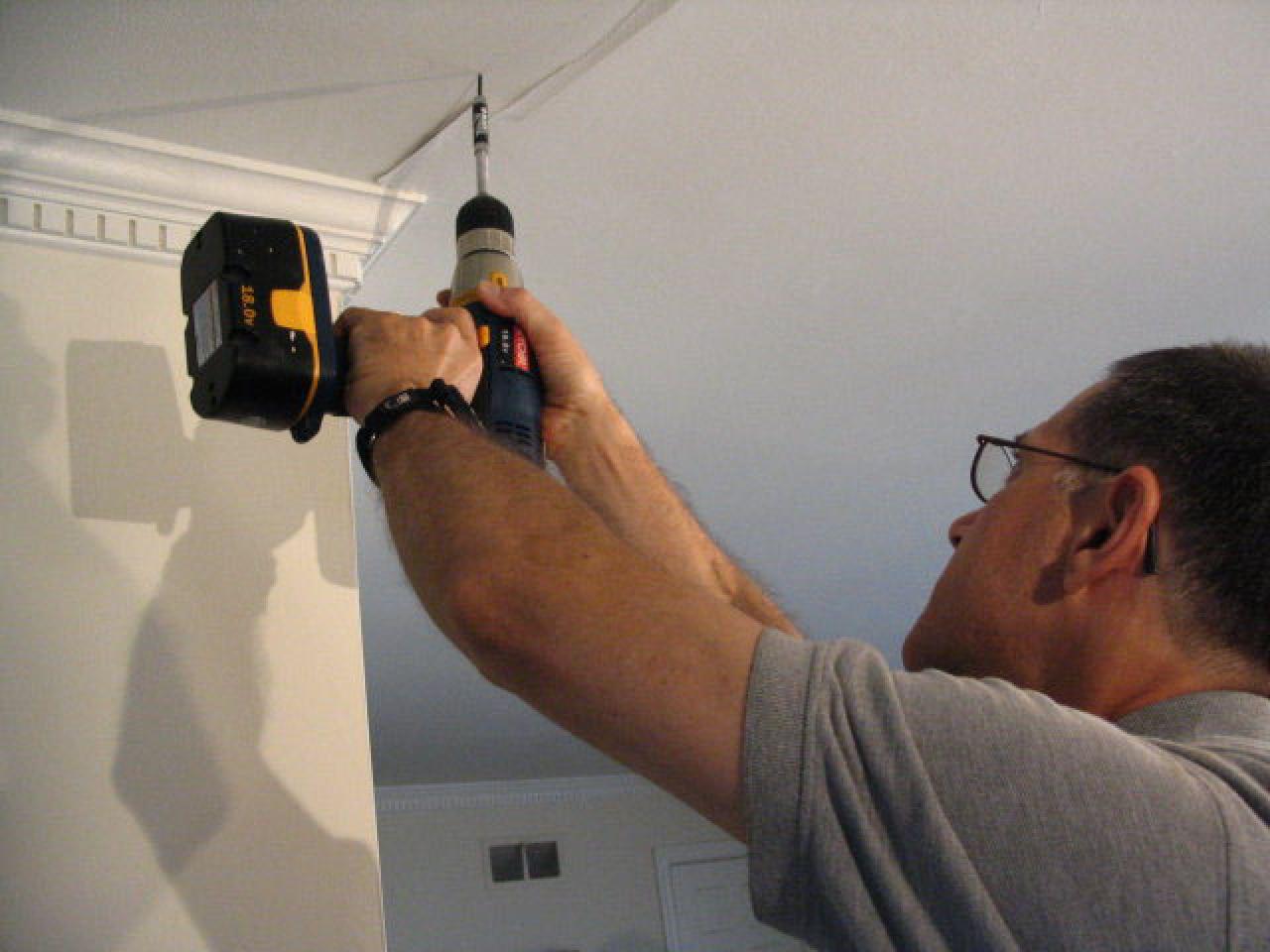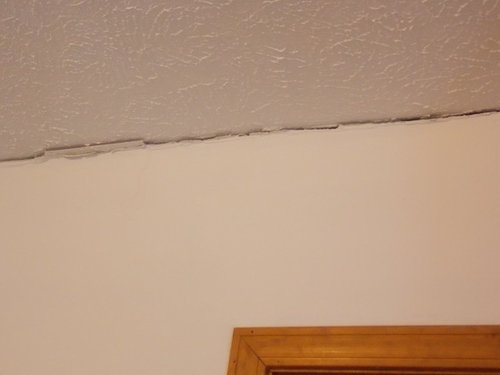Cracks in the drywall and plaster are a very common occurrence. They occur over time when there is stress or even a little settlement of the home. Contractors may call them hairline cracks, meaning that they are very thin looking. The majority of the time they are considered cosmetic and can be covered over when repainting is done.
Where do you often see drywall cracks?
- In the last few weeks, I have discovered a hairline crack in the ceiling above our living room. Its now about 2-3 in length. It is extending from casing holding fluorescent lights over the kitchen. I have read online regarding this and have seen a few different causes of it. I was hoping to get a permanent fix to this and not a cover up job.
- The cracks are mainly appearing on the ceiling, particularly in corners of rooms along the edges where the coving meets the ceiling, and along the joins in the coving itself.
These cracks are most commonly seen in areas where the structure develops more stress than other areas. The most common areas are the corners of doors and windows as well as the corners of wall openings. This is true of both exterior and interior doors and openings.
Spider Web Cracks As the name suggests, spider web cracks are those cracks that have a center point and then spread out in different directions. These cracks are a normal part of home settling and can occur in ceilings, walls, and even floors. When it comes to spider web cracks, size is important.
Another common place to see these cracks is where two pieces of drywall come together. These cracks usually run either horizontal or vertical at the drywall seams. Homes with vaulted ceilings may develop these cracks in the higher areas as well.
Additionally, drywall cracks are often found where two pieces of drywall are butted together. This occurs because there is a joint, which gets drywall taped and then layered with two or three coats of drywall mud. These joint areas are weaker than in the center, or field area of the drywall, therefore some cracks may occur at these joints.
Common causes of drywall cracks
As previously mentioned, stress is usually the main reasons that cracks occur. However, there are many potential causes of stress; some of the more common ones are:
- Wood framing drying out; the wood cures or loses moisture as it ages, causing the lumber to twist or warp a little and even a little dimensional change occurs.
- Movement of the structure:
1. Wind loads from storms, creating stresses on walls and ceilings
2. Settling of the home or soil movement
3. Expansive soils pushing up on the structure
4. Wet and dry seasons

5. Expansion and contraction due to hot and cold weather (this can be common in vacation homes and homes that have been left vacant due to the fact that the internal temperature of the home has been allowed to get higher and lower depending on the outside temps)
6. Earthquakes – if the home is in an area that has trimmers or earthquakes
7. Truss uplift – can create cracks where interior walls meets ceiling (read more)
8. Poor quality workmanship in taping the drywall joints. (Too much mud, too little mud, missing drywall tape, and drywall secured with internal stresses are some causes)
- Removal of “Pop-corn,” textured or “cottage cheese” looking ceiling material may leave a drywall taping job that tends to crack at the drywall joint. This often happens because the home builder knew that they were going to texture the ceiling, so they had the drywall contractor put on less coats of drywall mud over the joints since it would save money and would be covered with a textured material. i.e. a “pop-corn” ceiling material. With fewer coatings over the joints, the more likely a crack will develop.
Some cracks may be a “Red” flag under a few circumstances.
Wide cracks or cracks that run at an angel or diagonally may be a “Red” flag. It is important to note that while these cracks should be looked at more closely, these types of cracks may not be serious. Whether or not these cracks are serious is dependent on the particular circumstances.
If concerned, do a quick structural check of the home
First step outside the home and walk around the exterior; check for:
- Cracks in the foundation or is it bowed or leaning(READ MORE)
- Cracks in the siding or stucco (a few small cracks are common)
- Does the roof sag or is it bowed
- If there is a basement, check for cracked or bowing walls

Walk around the inside:
- Are the floors level or sloping
- Do any doors rub the flooring
- Are any doors or windows sticking
- Look for sagging ceilings and bowed walls
The above items can be an indication that a structural issues may exist, depending on the location and severity. If so, some of these issues may need to be addressed to help keep the drywall cracks from coming back.
Who can fix drywall cracks?
Handymen, homeowners, painters or drywall tapers

For the majority of cracks a painter would be the appropriate person to seal and cover the cracks. At times, a drywall contractor or a skilled handyman who can tape and mud joints may be needed. There are many products that can be used such as mesh tape, mesh patch kits, drywall mud and caulking. In some instances depending on the type of texture on the wall, it may be difficult for the homeowner to properly match the existing texture pattern. In this case an experienced drywall contractor is recommended although the majority of small cracks can be filled and repainted such that they cannot be noticed easily. By using a mesh tape product the crack is less likely to show up again. Simply applying some drywall mud or spackle will not be very strong and you may find that even the normal expansion and contraction from temperature fluctuations may be enough to cause the crack again.
Additional Resources
If a load bearing wall is removed, there are structural issues and risks that homeowners and buyers should be aware of.
Do you believe that tree roots can really cause the drywall to crack in a home?
When the drywall tape in a corner area or where the wall meets the ceiling has a wrinkled look, then it may be caused by humidity, workmanship or movement
Know which ceiling cracks are serious and which ones are just cosmetic.
Drywall nails and screws sticking out or sunken in? Is the house new or old? Then...
Has the drywall tape come loose or is there wrinkles in it? Then...
How do you recognize mold and get rid of it? Does Insurance cover it?
Mold may cause or aggravate health issues under some circumstances.
Can you get rid of mold yourself? Are there legal considerations?
Hairline ceiling cracks are usually common in homes. In most occasions, hairline cracks are cosmetic in nature and can be repaired swiftly and easily. It’s also significant to examine the cause of the hairline crack, its shape, exact location, the size before fixing it. In some cases, it could be an indication of a more complex problem that requires a more intensive home remodeling effort. Some of the most common causes of hairline cracks include poorly and weakly taped joints and moisture above the ceiling. Extreme drywall application and trusses uplift could also cause hairline cracks. In cases of humidity, it’s always better to examine what could have caused the moisture to accumulate above the ceiling. The below hairline ceiling crack repair tips provide quick guidance on what to do.
1. Start by Examining the Hairline Crack
First off, it is essential that the cause of the ceiling hairline crack be determined. This will aid in getting the required material in repairing the hairline crack and preventing such problems in future.
2. Cleaning and Taping
In cases where the crack is cosmetic, consider cleaning the crack and remove the old points and drywall. Cleaning also ensures that the discolored part is refined before repair. After cleaning, the repairer should mesh tape along the line of the crack. The tape should also be placed carefully and run along the center of the crack.
3. Spreading the Compound
Using a utility or a putty knife; carefully spread the compound over the tape. Make sure that it covers the entire tape and that it appears flat. This avoids bumpiness on completion of the process. It’s advisable to cover the tape with plenty of compounds, rather than just applying a thin layer on the tape. Once done, you can refine the compound to a reasonable side using sandpaper.
4. Painting
Preparation
Painting is the other important step in hairline ceiling crack repair. Before painting, it is significant to make sure that the crack in the ceiling is completely covered. Also, ensure that the edges are fine. When making the edges fine, a putty knife can be resourceful. However, be sure to not to tamper with the tape. This process requires a lot of caution since more often than not, there’s a lot of dust to deal with.
Using an eye protector can come in hand during this final part of the process. Also, it would be proper to cover the furniture in your house. You don’t want to go back shopping for your precious furniture. Depending on what the type of furniture you own is made from, getting rid of paint can be a nightmare.
Addl Painting Tips
Always remember, the painting process comes in only when the edges have been refined. Also, be sure to select a paint that is similar to the one previously applied to the entire ceiling board. In case you’re applying two paint coats, which are preferable, you’ll want to allow the first coat to dry completely. Afterward, you can use a fine tooth sanding paper to prepare the surface before dusting and applying the second coat.
Paint Types

Also worth noting, there are many different types of paint depending on color, application method, and time taken before drying. Some such as nitrocellulose paints (NC) takes just a few seconds to dry up. Others may as well take 2 to a few days (slow dry) before drying enough to allow the second coat. You can also mix up paints of the same density and strength to get your desired color and finish. Thinned paints tend to dry faster. Some of the most common thing paint thinners include the following:
• Turpentine,
• White spirit
• Acetone
• Methyl ethyl ketone
• Toluene
• Ethylbenzene
If you’re using a fast-drying paint, go for a nitrocellulose universal thinner, preferably the same brand as the paint.
In Closing…
Hairline ceiling cracks are not as complicated as wall cracks, which are more often than not hazardous and structural. Discolored hairline cracks require more examination of the causes of leaks. When repairing the cracks also, it’s crucial to avoid compounds that may lead to stress on your ceiling. More stress could lead to cracking, even after the repair. Nonetheless, the wisest way to go about it is to hire an experienced contractor for the job. Much as saving a buck is important to anyone; no one appreciates fixing the same thing after every few months.
1: KILZ Interior Ceiling Paint
Hairline Cracks In Ceiling Drywall
• Buy From: WalMart
• Price: $33.32
• Link:https://is.gd/y6Alv3

Hairline Cracks In Ceilings And Walls
2: Polycell Crack-Free Ceilings Smooth Silk 2.5L
• Buy From: Amazon
• Price: $78.09
• Link:https://is.gd/1RVtge